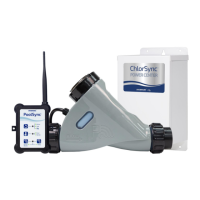Page - 6
Cell
The cell includes buttons, a digital display, and LED indicators to control the ChlorSync
®
and
chlorine production. See "User Display" on page 8 for more information. The ChlorSync
®
unit
measures water flow, water temperature and salt levels. If the salt level in the pool water falls
below 2,300 ppm (mg/L), the unit will not produce chlorine until more salt is added to the body of
water. The cell is equipped with a self-cleaning feature that reverses the cell polarity and
removes normal calcium build up. The self cleaning process occurs at predetermined times
throughout the day.
If the water is excessively unbalanced and scale forming, the self cleaning process may not be
able to remove all
scale. See "Water Balance and Chemistry Recommendations" on page 9.
ChlorSync
®
Cell
Figure 2
The ChlorSync
®
sanitizer output can be set by adjusting the output level on the control unit. The
pool pump run time, combined with the output setting, will determine how much sanitizer is
produced each day.
The unit is capable of monitoring water flow, water temperature, and salt level with the following
components:
l
Flow Sensor: The cell is equipped with a sensor that will detect flow. If the water flow is not adequate due
to improper plumbing or other conditions, the unit will not produce chlorine.
l
Salt Sensor: The ChlorSync
®
will measure the pool water salt level as follows:
l Every twelve (12) hours during normal operation
l At system power up or reset
l When flow is initially detected
l Once every hour during a low salt condition (less than 2,700 ppm)
l
Temperature Sensor: The ChlorSync
®
uses the temperature sensor to protect the unit from damage
caused by extreme cold water conditions. Chlorine production will be reduced by way of the temperature
compensation feature. The chlorinator uses the temperature sensor for the Automatic Temperature
Compensation feature described in detail. See "Patented Temperature Compensation" on page 7. This
feature automatically lowers the chlorine output setting as water temperature decreases, and raises
output as water temperature increases.

